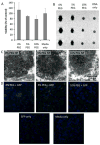A versatile and tunable coating strategy allows control of nanocrystal delivery to cell types in the liver
- PMID: 21361312
- PMCID: PMC3059339
- DOI: 10.1021/bc1003179
A versatile and tunable coating strategy allows control of nanocrystal delivery to cell types in the liver
Abstract
There are many liver diseases that could be treated with delivery of therapeutics such as DNA, proteins, or small molecules. Nanoparticles are often proposed as delivery vectors for such therapeutics; however, achieving nanoparticle accumulations in the therapeutically relevant hepatocytes is challenging. In order to address this issue, we have synthesized polymer coated, fluorescent iron oxide nanoparticles that bind and deliver DNA, as well as produce contrast for magnetic resonance imaging (MRI), fluorescence imaging, and transmission electron microscopy (TEM). The composition of the coating can be varied in a facile manner to increase the quantity of poly(ethylene glycol) (PEG) from 0% to 5%, 10%, or 25%, with the aim of reducing opsonization but maintaining DNA binding. We investigated the effect of the nanoparticle coating on DNA binding, cell uptake, cell transfection, and opsonization in vitro. Furthermore, we exploited MRI, fluorescence imaging, and TEM to investigate the distribution of the different formulations in the liver of mice. While MRI and fluorescence imaging showed that each formulation was heavily taken up in the liver at 24 h, the 10% PEG formulation was taken up by the therapeutically relevant hepatocytes more extensively than either the 0% PEG or the 5% PEG, indicating its potential for delivery of therapeutics to the liver.
Figures





References
-
- Ferry N, Heard JM. Liver-directed gene transfer vectors. Hum Gene Therapy. 1998;9:1975–1981. - PubMed
-
- Innerarity TL, Mahley RW, Weisgraber KH, Bersot TP, Krauss RM, Vega GL, Grundy SM, Friedl W, Davignon J, McCarthy BJ. Familial defective apolipoprotein B-100: a mutation of apolipoprotein B that causes hypercholesterolemia. J Lipid Res. 1990;31:1337–1349. - PubMed
-
- Bacon BR, Olynyk JK, Brunt EM, Britton RS, Wolff RK. HFE genotype in patients with hemochromatosis and other liver diseases. Ann Intern Med. 1999;130:953–962. - PubMed
-
- Gooptu B, Ekeowa UI, Lomas DA. Mechanisms of emphysema in {alpha}1-antitrypsin deficiency: molecular and cellular insights. Eur Respir J. 2009;34:475–488. - PubMed
-
- Raper SE, Yudkoff M, Chirmule N, Gao GP, Nunes F, Haskal ZJ, Furth EE, Propert KJ, Robinson MB, Magosin S, Simoes H, Speicher L, Hughes J, Tazelaar J, Wivel NA, Wilson JM, Batshaw ML. A pilot study of in vivo liver-directed gene transfer with an adenoviral vector in partial ornithine Transcarbamylase deficiency. Human Gene Therapy. 2002;13:163–175. - PubMed
Publication types
MeSH terms
Substances
Grants and funding
LinkOut - more resources
Full Text Sources
Other Literature Sources

